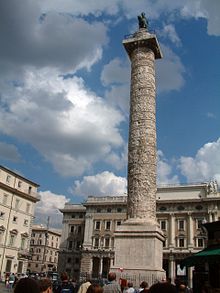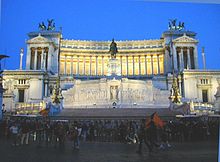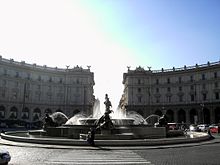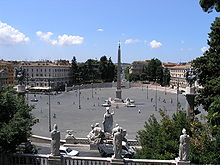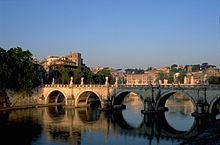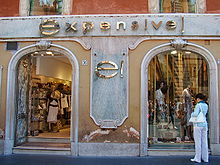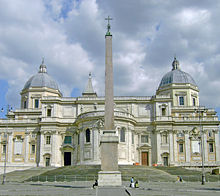- Culture in Rome
-
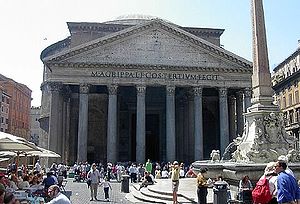 The Pantheon.
The Pantheon.
The Culture of Rome refers to the arts, high culture, language, religion, politics, cuisine, architecture and fashion in Rome, Italy. Rome was supposedly founded in 753 BC and eversince has been the capital of the Roman Empire, one of the main centres of Christianity, the home of the Roman Catholic Church and the seat of the Italian Republic. Due to its historical and social importance, Rome is often nicknamed the Caput Mundi, or "capital of the world".[1]
Contents
The arts
Main article: Arts in RomeArchitecture and city layout
Main article: Architecture of Rome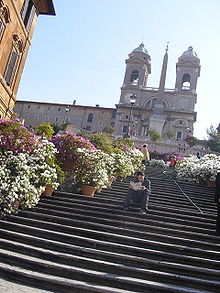 The Spanish Steps
The Spanish Steps
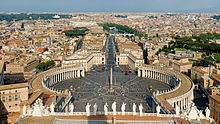 Saint Peter's Square, Vatican City
Saint Peter's Square, Vatican City
Ancient Rome
Main article: Roman architectureOne of the symbols of Rome is the Colosseum (70-80 AD), the largest amphitheatre ever built in the Roman Empire. Originally capable of seating 60,000 spectators, it was used for gladiatorial combat. The list of the very important monuments of ancient Rome includes the Roman Forum, the Domus Aurea, the Pantheon, Trajan's Column, Trajan's Market, the several catacombs area, the Circus Maximus, the Baths of Caracalla, Castel Sant'Angelo, the Mausoleum of Augustus, the Ara Pacis, the Arch of Constantine, the Pyramid of Cestius, and the Bocca della Verità.
Medieval
See also: Medieval architectureOften overlooked, Rome's medieval heritage is one of the largest in Italian cities. Basilicas dating from the Paleochristian age include Santa Maria Maggiore and San Paolo Fuori le Mura (the second largely rebuilt in the 19th century), both housing precious 4th century AD mosaics. Later notable medieval mosaic and fresco art can be also found in the churches of Santa Maria in Trastevere, Santi Quattro Coronati and Santa Prassede. Lay buildings include a number of towers, the largest being the Torre delle Milizie and the Torre dei Conti, both next the Roman Forum, and the huge staircase leading to the basilica of Santa Maria in Ara Coeli.
Renaissance and Baroque
See also: Renaissance architectureSee also: Baroque architectureRome was a major world center of the Renaissance, second only to Florence, and was profoundly affected by the movement. The most impressive masterpiece of Renaissance architecture in Rome is the Piazza del Campidoglio by Michelangelo, along with the Palazzo Senatorio, seat of the city government. During this period, the great aristocratic families of Rome used to build opulent dwellings as the Palazzo del Quirinale (now seat of the President of the Republic), the Palazzo Venezia, the Palazzo Farnese, the Palazzo Barberini, the Palazzo Chigi (now seat of the Prime Minister), the Palazzo Spada, the Palazzo della Cancelleria, and the Villa Farnesina.
Rome is also famous for her huge and majestic squares (often adorned with obelisks), many of which were built in the 17th century. The principal squares are Piazza Navona, Piazza di Spagna, Campo de' Fiori, Piazza Venezia, Piazza Farnese and Piazza della Minerva. One of the most emblematic examples of the baroque art is the Fontana di Trevi by Nicola Salvi. Other notable baroque palaces of 17th century are the Palazzo Madama, now seat of the Italian Senate and the Palazzo Montecitorio, now seat of the Chamber of Deputies of Italy.
Neoclassicism
See also: Neoclassical architectureIn 1870, Rome became capital city of the new Kingdom of Italy. During this time, neoclassicism, a building style influenced by the architecture of Antiquity, became a predominant influence in Roman architecture. In this period many great palaces in neoclassical styles were built to host ministries, embassies and other governing agencies. One of the best-known symbol of Roman neoclassicism is the Monument of Vittorio Emanuele II or "Altar of Fatherland", where the grave of the Unknown Soldier, that represents the 650,000 Italians that fell in World War I, is located.
Fascist architecture
See also: Fascist architectureThe Fascist regime that ruled in Italy between 1922 and 1943 developed an architectural style which was characterized by its linkages with ancient Rome architecture. The most important fascist site in Rome is the E.U.R. district, built in 1935. It was originally conceived for the 1942 world exhibition, and was called "E.42" ("Esposizione 42"). However, the world exhibition never took place because Italy entered the Second World War in 1940. The most representative building of the Fascist style at E.U.R. is the Palazzo della Civiltà Italiana (1938–1943), the iconic design of which has been labeled the cubic or Square Colosseum. After World War II, the Roman authorities found that they already had the seed of an off-centre business district that other capitals were still planning (London Docklands and La Defense in Paris). Also the Palazzo della Farnesina, the actual seat of Italian Foreign Ministry, was designed in 1935 in fascist style.
Vatican City
Main article: Vatican CityThe city of Rome surrounds the Vatican City, the enclave of the Holy See, which is a separate sovereign state. It hosts Saint Peter's Square with the Saint Peter's Basilica. The open space before the basilica was redesigned by Gian Lorenzo Bernini, from 1656 to 1667, under the direction of Pope Alexander VII, as a forecourt, designed "so that the greatest number of people could see the Pope give his blessing, either from the middle of the façade of the church or from a window in the Vatican Palace" (Norwich 1975 p 175). In Vatican City there are also the Vatican Library, Vatican Museums with the Sistine Chapel, the Raphael Rooms and other important works of Leonardo Da Vinci, Raphael, Giotto, and Botticelli.
Museums and galleries
The most important museums and galleries of Rome include the National Museum of Rome, the Museum of Roman Civilization, the Villa Giulia National Etruscan Museum, the Capitoline Museums, the Borghese Gallery, the Museum of Castel Sant'Angelo, and the National Gallery of Modern Art.[citation needed]
Villas and gardens
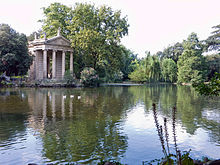 Villa Borghese: the 19th century "Temple of Aesculapius" built purely as a landscape feature, influenced by the lake at Stourhead, Wiltshire, England
Villa Borghese: the 19th century "Temple of Aesculapius" built purely as a landscape feature, influenced by the lake at Stourhead, Wiltshire, England
The center of Rome is surrounded by some large green areas and opulent ancient villas, which are the remains of the crowns of villas which encircled the papal city. Most of them were largely destroyed by real estate speculation at the end of the 19th century. The most important among the surviving ones are:
- Villa Borghese, with a large landscape garden in the naturalistic 19th century English style, containing a number of buildings, museums (see Galleria Borghese) and attractions;
- Villa Ada, the largest public landscaped park of Rome;
- Villa Doria Pamphili, the second largest with an area of 1.8 km²;
- Villa Torlonia, a splendid example of Art Nouveau mansion that was the Roman residence of Benito Mussolini;
- Villa Albani, commissioned by Cardinal Alessandro Albani to house his collection of antiquities and Roman sculpture, which soon filled the casino that faced the Villa down a series of formal parterres.
Art
Rome contains a vast and impressive collection of art, sculpture, fountains, mosaics, frescos, and paintings, from all different periods. Rome first became a major artisic centre during ancient Rome, with forms of important Roman art such as architecture, painting, sculpture and mosaic work. Metal-work, coin-die and gem engraving, ivory carvings, figurine glass, pottery, and book illustrations are considered to be 'minor' forms of Roman artwork.[2] Rome later became a major centre of Renaissance art, since the popes spent vast sums of money for the constructions of grandiose basilicas, palaces, piazzas and public buildings in general. Rome became one of Europe's major centres of Renaissance artwork, second only to Florence, and able to compare to other major cities and cultural centres, such as Paris and Venice. The city was affected greatly by the baroque, and Rome became the home of numerous artists and architects, such as Bernini, Caravaggio, Carracci, Borromini and Cortona, to name a few.[3] In the late-18th century and early-19th century, the city was one of the centres of the Grand Tour,[4] when wealthy, young English and other European aristocrats visited the city to learn about ancient Roman culture, art, philosophy and architecture. Rome hosted a great number of neoclassical and rococo artists, such as Pannini and Bernardo Bellotto. Today, the city is a major artistic centre, with numerous art institutes[5] and museums.
Cinema
 The Roman Holiday, a popular American film set in Rome.
The Roman Holiday, a popular American film set in Rome. Main articles: List of films set in Rome and List of films set in ancient Rome
Main articles: List of films set in Rome and List of films set in ancient RomeRome hosts the Cinecittà Studios,[6] the largest film and television production facility in continental Europe and the centre of the Italian cinema, where a large number of today's biggest box office hits are filmed. The 99-acre (40-ha) studio complex is 5.6 miles (9 km) from the centre of Rome and is part of one of the biggest production communities in the world, second only to Hollywood, with well over 5,000 professionals—from period costume makers to visual effects specialists. More than 3,000 productions have been made on its lot, from recent features like The Passion of the Christ, Gangs of New York, Adult Swim, The Life Aquatic and Dino De Laurentiis’ Decameron, to such cinema classics as Ben-Hur, Cleopatra, and the films of Federico Fellini.
Founded in 1937 by Benito Mussolini, the studios were bombed by the Western Allies during the Second World War. In the 1950s, Cinecittà was the filming location for several large American film productions, and subsequently became the studio most closely associated with Federico Fellini. Today Cinecittà is the only studio in the world with pre-production, production, and full post-production facilities on one lot, allowing directors and producers to walk in with their script and "walk out" with a completed film.
Fashion
See also: Shopping areas and markets in RomeRome is widely recognized as one of the world’s fashion capitals.[7] Major luxury fashion houses and jewelry chains, including Bulgari, Fendi, Laura Biagiotti and Brioni, are headquartered in the city, or were founded there, and other major labels, including Chanel, Prada, Dolce & Gabbana, Armani and Versace have luxury boutiques in Rome, primarily on Via dei Condotti.
Religion
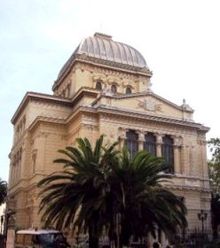 The Great Synagogue of Rome
The Great Synagogue of Rome Central mosque by Paolo Portoghesi, Rome (1974)
Central mosque by Paolo Portoghesi, Rome (1974)
Much like the rest of Italy, Rome is predominantly Roman Catholic. Although Rome is home to the Vatican City and St. Peter's Basilica, Rome's cathedral is the Basilica of St. John Lateran, located to the south-east of the city-centre. There are around 900 churches in Rome in total, aside from the cathedral itself, some others of note include: the Basilica di Santa Maria Maggiore, the Basilica of Saint Paul Outside the Walls, the Basilica di San Clemente, San Carlo alle Quattro Fontane and the Church of the Gesu. There are also the ancient Catacombs of Rome underneath the city. Numerous highly important religious educational institutions are also in Rome, such as the Pontifical Lateran University, Pontifical Biblical Institute, Pontifical Gregorian University, and Pontifical Oriental Institute.
The territory of Vatican City is part of the Mons Vaticanus, and of the adjacent former Vatican Fields, where St. Peter's Basilica, the Apostolic Palace, the Sistine Chapel, and museums were built, along with various other buildings. The area was part of the Roman rione of Borgo until 1929. Being separated from the city, on the west bank of the Tiber river, the area was an outcrop of the city that was protected by being included within the walls of Leo IV, and later expanded by the current fortification walls of Paul III/Pius IV/Urban VIII. When the Lateran Treaty of 1929 that gave the state its present form was being prepared, the boundaries of the proposed territory was influenced by the fact that much of it was all but enclosed by this loop. For some tracts of the frontier, there was no wall, but the line of certain buildings supplied part of the boundary, and for a small part of the frontier a modern wall was constructed.
The territory includes Saint Peter's Square, distinguished from the territory of Italy only by a white line along the limit of the square, where it touches Piazza Pio XII. St. Peter's Square is reached through the Via della Conciliazione, which runs from the Tiber River to St. Peter's. This grand approach was constructed by Benito Mussolini after the conclusion of the Lateran Treaty. According to the Lateran Treaty, certain properties of the Holy See that are located in Italian territory, most notably Castel Gandolfo and the major basilicas, enjoy extraterritorial status similar to that of foreign embassies.
In recent years, the Islamic community has grown significantly, in great part due to immigration from North African and Middle Eastern countries into the city. As a consequence of this trend, the comune promoted the building of the largest mosque in Europe, which was designed by architect Paolo Portoghesi and inaugurated on June 21, 1995.
Language
The original language of Rome was Latin, which evolved during the Middle Ages into Italian. The latter emerged as the confluence of various regional dialects, among which the Tuscan dialect predominated, but the population of Rome also developed its own dialect, the Romanesco. The ancient romanesco, used during the Middle Ages, was a southern Italian dialect, very close to the Neapolitan. The influence of the Florentine culture during the renaissance, and, above all, the immigration to Rome of many Florentines who were among the two Medici Popes' (Leo X and Clement VII) suite, caused a strong change of the dialect, which resembled more the Tuscan varieties (the immigration of Florentines was mainly due to the Sack of Rome in 1527 and the subsequent demographic decrease). This remained largely confined to Rome until the 19th century, but then expanded other zones of Lazio (Civitavecchia, Latina), from the beginning of the 20th century, thanks to the rising population of Rome and to better transportation systems. As a consequence, Romanesco abandoned its traditional forms to mutate into the dialect spoken within the city, which is more similar to standard Italian, although remaining distinct from other Romanesco-influenced local dialects of Lazio. Dialectal literature in the traditional form Romanesco includes the works of such authors as Giuseppe Gioacchino Belli, Trilussa, and Cesare Pascarella. Contemporary Romanesco is mainly represented by popular actors such as Aldo Fabrizi, Alberto Sordi, Nino Manfredi, Anna Magnani, Gigi Proietti, Enrico Montesano, and Carlo Verdone.
Education
Universities
The city’s first university, La Sapienza, was founded in 1303. It is the largest university in Europe and the second largest in the world, with more than 150,000 students attending.[citation needed] Two further large public universities were founded in the late 20th century: Tor Vergata in 1982, and Roma Tre in 1992; today each has around 38,000 students. Also state-supported is IUSM, a vocational university with 2000 students located in the Foro Italico district and dedicated exclusively to sports and movement sciences.[8]
A large number of pontifical universities and institutes are located in Rome, including the Pontifical Gregorian University, founded in 1551 and the oldest Jesuit university in the world, and the Pontifical University of St. Thomas Aquinas (the ‘Angelicum’) which represents the Dominican tradition.
The city is also home to a number of private universities. The Libera Università Maria SS. Assunta (LUMSA) is a Catholic institution founded in 1939. LUISS, founded in 1966, has faculties of Economics, Law and Political Science. The Università Campus Bio-Medico is a small Catholic university which focusses on medicine, nursing and biomedical engineering. The Libera Università degli Studi San Pio V, founded in 1966, has faculties of Economics, Foreign Languages and Literature, and Political Sciences. There are also Roman centres of the Milanese Università Cattolica del Sacro Cuore and of the Istituto Europeo di Design, a design school founded in Milan in 1966 which now has a presence in eight cities and two continents.
Foreign universities based in Rome include the American University of Rome and the John Cabot University: private American liberal arts institutions founded in 1969 and 1972 respectively The Link Campus is an international university initially constituted as the Italian branch of the University of Malta. Also present are St. John's University, a branch of the St. John's University in New York and the John Felice Rome Center, of Loyola University Chicago.
References
- ^ s.v. "Urbe", De Mauro Paravia.
- ^ Toynbee, J. M. C. (December 1971). "Roman Art". The Classical Review 21 (3): 439–442. doi:10.1017/S0009840X00221331. JSTOR 708631.
- ^ Trincoll.edu
- ^ About.com
- ^ Trincoll.edu
- ^ "history of Cinecittà Studios in Rome". Romefile.com. http://www.romefile.com/culture/cinecitta.php. Retrieved 2009-10-17.
- ^ The 2009 Global Language Monitor[unreliable source?] survey, for instance, ranked it at number four:after Milan, New York and Paris, but ahead of London. In 2008 it had been placed first in Europe and second in the world, after New York City."The Global Language Monitor » Fashion". Languagemonitor.com. 2009-07-20. http://www.languagemonitor.com/popular-culture/fashion. Retrieved 2009-10-17.
- ^ IUSM The University: Italian University of Sport and Movement, IUSM.
Categories:- Italian culture
- Culture in Rome
Wikimedia Foundation. 2010.

